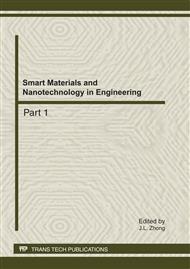[1]
J. Burns, T. Yokota, H. Ashihara, M.E. Lean and A. Crozier, Variations in the profile and content of anthocyanins in wines made from Cabernet Sauvignon and hybrid grapes, Journal ofAgricultural and Food Chemistry, Vol. 50, no. 14, pp.4096-4102, June (2002).
DOI: 10.1021/jf011233s
Google Scholar
[2]
B. B. Aggarwal, A. Bhardwaj, R. S. Aggarwal, N. P. Seeram, S. Shishodia and Y. Takada, Role of resveratrol in prevention and therapy of cancer: preclinical and clinical studies, Anticancer Research, Vol. 24, no. 5A, pp.2783-2840, September-October (2004).
Google Scholar
[3]
I. Kolouchova, K. Melzoch, J. Smidrkal and V. Filip, Rapid method for resveratrol determination by HPLC with electrochemical and UV detections in wines, Food Chemistry, Vol. 87, no. 1, pp.151-158, August (2004).
DOI: 10.1016/j.foodchem.2004.01.028
Google Scholar
[4]
S. Ulrik, V. Ole and B. Christine, A review of the content of the putative chemopreventive phytoalexin resveratrol in red wine, Food Chemistry, Vol. 101, no. 2, pp.449-457, (2007).
DOI: 10.1016/j.foodchem.2006.01.047
Google Scholar
[5]
A. M. Alonso, C. Dominguez, D. A. Guillen and C. G. Barroso, Determinations of antioxidant power of red and white wines by a new electrochemical method and its correlation with polyphenolic content, Journal of Agricultural and Food Chemistry, Vol. 50, no. 11, pp.3112-3115, April (2002).
DOI: 10.1021/jf0116101
Google Scholar
[6]
M. Jang, L. Cai, G. O. Udeani, K. V. Slowing, C. F. Thomas and C. W. Beeche, Cancer chemopreventive activity of resveratrol, a natural product derived from grapes, Science, Vol. 275, no. 5297, pp.218-220, January (1997).
DOI: 10.1126/science.275.5297.218
Google Scholar
[7]
M. Abril, A. I. Negueruela, C. Perez, T. d Juan and G. Estopanan, Preliminary study of resveratrol content in Aragon red and rose wines, Food Chemistry, Vol. 92, no. 4, pp.729-736, October (2005).
DOI: 10.1016/j.foodchem.2004.08.034
Google Scholar
[8]
K. Langer, M.G. Anhorn, I. Steinhauser, S. Dreis, D. Celebi, N. Schrickel, S. Faust and V. Vogel, Human serum albumin (HSA) nanoparticles: Reproducibility of preparation process and kinetics of enzymatic degradation, International Journal of Pharmaceutics, Vol. 347, no. 1-2, pp.109-117, January (2008).
DOI: 10.1016/j.ijpharm.2007.06.028
Google Scholar
[9]
K. Felix, Albumin as a drug carrier: Design of prodrugs, drug conjugates and nanoparticles, Journal of Controlled Release, Vol. 132, no. 3, pp.171-183, December (2008).
DOI: 10.1016/j.jconrel.2008.05.010
Google Scholar
[10]
C. Weber, C. Coester, J. Keruter and K. Langer, Desolvation process and surface characterization of protein nanoparticles, International Journal of Pharmaceutics, Vol. 194, no. 1, pp.91-102, January (2000).
DOI: 10.1016/s0378-5173(99)00370-1
Google Scholar
[11]
Y. G. Zu, Y. Zhang, X. H. Zhao, Q. Zhang, Y. Liu and R. Jiang, Optimization of the preparation process of vinblastine sulfate (VBLS)-loaded folate-conjugated bovine serum albumin (BSA) nanoparticles for tumor-targeted drug delivery using response surface methodology (RSM), International Journal of Nanomedicine, Vol. 1, no. 4, pp.321-333, January (2009).
DOI: 10.2147/ijn.s8501
Google Scholar
[12]
M. Adrian, P. Jeandet, A. C. Breuil, D. Levite, S. d Debord and R. Bessis, Assay of resveratrol and derivative stilbenes in wines by direct injection high performance liquid chromatography, American Journal of Enology and Viticulture, Vol. 51, no. 1, pp.37-41, (2000).
DOI: 10.5344/ajev.2000.51.1.37
Google Scholar


